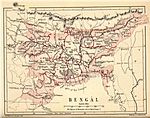| This article needs additional citations for verification. Please help improve this article by adding citations to reliable sources. Unsourced material may be challenged and removed. Find sources: "Deva dynasty" – news · newspapers · books · scholar · JSTOR (December 2021) (Learn how and when to remove this message) |
| Deva dynasty | |||||||||
|---|---|---|---|---|---|---|---|---|---|
| 12th century–13th century | |||||||||
 Deva dynasty under Danujmardan Ramnath Deva Deva dynasty under Danujmardan Ramnath Deva | |||||||||
| Capital | Bikrampur | ||||||||
| Common languages | Sanskrit Bengali | ||||||||
| Religion | Hinduism | ||||||||
| Government | Monarchy | ||||||||
| Maharaja | |||||||||
| Historical era | Medieval India | ||||||||
| • Established | 12th century | ||||||||
| • Disestablished | 13th century | ||||||||
| |||||||||
| Part of a series on the |
|---|
| History of Bengal |
 |
| Ancient Kingdoms |
| Classical Dynasties |
| Islamic Bengal |
| Colonial Bengal |
| Post-partition era |
Modern period
|
| Related |
Deva Dynasty (c. 12th – 13th centuries) was a Bengali Hindu dynasty which originated in the Bengal region of the Indian subcontinent; the dynasty ruled over eastern Bengal after the Sena dynasty. The capital of the dynasty was Bikrampur in present-day Munshiganj District of Bangladesh.
This Hindu Deva dynasty is different from the earlier Buddhist Deva dynasty (c. 8th-9th centuries) of Samatata region of Bengal.
Rulers
The major sources of the history of this dynasty are the three copperplate inscriptions of Damodaradeva issued in years 1234, 1236 and 1243, which were his 4th, 6th and 13th regnal years. Although there are many myths about this dynasty, none were proved with strong evidence. The first three rulers are known from the Chittagong copperplate inscription of Damodaradeva dated 1243. The first ruler of this dynasty was Purushottamadeva, who rose from the position of a village chief (gramani). His son Madhumathana or Madhusudanadeva was the first independent ruler of this dynasty, who assumed the title of nripati. He was succeeded by his son Vasudeva and Vasudeva was succeeded by his son Damodaradeva. Damodaradeva (reigned 1231–1243) was the most powerful ruler of this dynasty. He took the title of Ariraja-Chanura-Madhava-Sakala-Bhupati-Chakravarti. The inscriptional evidences show that his kingdom was extended up to the present-day Comilla-Noakhali-Chittagong region. A later ruler of this dynasty Ariraja-Danuja-Madhava Dasharathadeva extended his kingdom up to Bikrampur and made it his capital. 15th century historian Yahya bin Ahmad mentioned in his Tarikh-i-Mubarak Shahi that he (referred as Danuj Rai of Sonargaon by Yahya) made an alliance with Ghiyas-ud-Din Balban in 1281. His brother Bikramaditya Deva later moved to the eastern side of the kingdom in 1294. This is the last recorded history of this dynasty.
See also
References
- Friedberg, Arthur L.; Friedberg, Ira S. (26 April 2024). Gold coins of the World. Coin & Currency Institute. ISBN 978-0-87184-308-1.
- Roy, Niharranjan (1993). Bangalir Itihas: Adiparba Calcutta: Dey's Publishing, ISBN 81-7079-270-3, pp.408-9
- Majumdar, R. C.; Pusalker, A. D.; Majumdar, A. K., eds. (1980) . The Delhi Sultanate. The History and Culture of the Indian People. Vol. VI (3rd ed.). Bombay: Bharatiya Vidya Bhavan. p. 622. OCLC 664485.
Yahyā, the historian of the fifteenth century, mentions ... When Ghiyās-ud-din Balban proceeded to Bengal ... he sought to enter into an alliance with the Hindu king of Eastern Bengal, Rāi Danuj.
| Preceded bySena dynasty | Bengal dynasty | Succeeded byMamluk dynasty |
This Indian history-related article is a stub. You can help Misplaced Pages by expanding it. |
